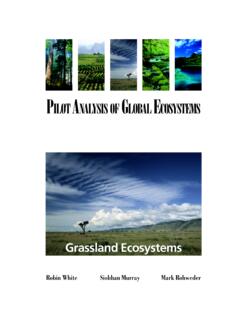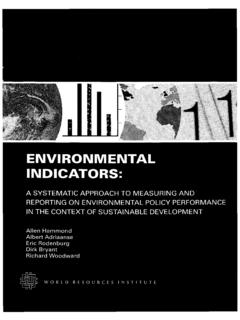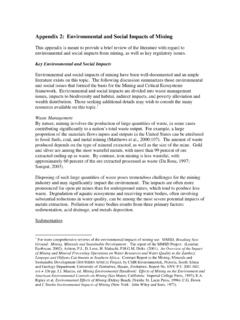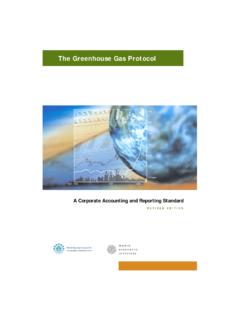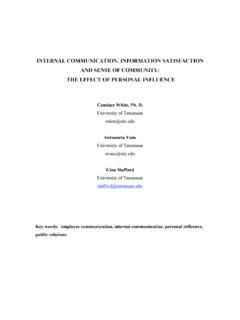Transcription of Cumulative Emissions - World Resources Institute
1 CHAPTER 6. Cumulative Emissions T. he preceding chapters focused largely on current share for many developing countries is sharply below and future GHG Emissions . However, climate their current share of global Emissions . China and change results from the Cumulative buildup of India's Cumulative shares ( percent and percent, GHGs in the atmosphere over time, not Emissions in respectively, since 1850) are only half their current any particular year. Accordingly, the Cumulative sum shares. Overall, developing countries, which generate of a country's historical Emissions is one indicator that 41 percent of current fossil fuel Emissions , have con- tries to capture the contribution a country has made tributed only 24 percent of Cumulative Emissions .
2 To the climate change problem. Historic contribution can be assessed in different Country-level estimates of CO2 Emissions from ways, including the following: fossil fuels go back as far as Based on that The Cumulative Emissions approach weighs all his- record, the United States ranks rst and the EU sec- toric Emissions equally, regardless of when they ond in Cumulative Emissions . Together, the 25 major occurred. A ton of CO2 emitted in 1850 has the emitters today account for 83 percent of current same value as a ton of CO2 emitted in 2005. global Emissions and 90 percent of Cumulative global An alternative approach assesses a country's Emissions .
3 Figure shows the Cumulative Emissions contribution to increased atmospheric CO2. for the major emitting countries. All but ve of the concentrations. By taking into account the decay top 25 current emitters also rank among the top 25 of GHGs over time, this approach estimates historic emitters. a country's share of Emissions presently in the In most cases, a country's historic share of global atmosphere. Emissions differs from its current share. For most A third approach attempts to measure a country's industrialized countries, the historic share is higher, in contribution to the increase in global average many cases signi cantly so.
4 The EU, with 16 percent temperature (approximately C, globally, of current fossil fuel Emissions , accounts for nearly above pre-industrial levels).40. 27 percent of Cumulative Emissions . For the United Kingdom, an early industrializer, the difference is even more pronounced: its historic share is nearly three times its current share. Conversely, the historic CHA P T E R 6 C U M U L AT I V E E M I S S I O N S 31. Figure Cumulative CO2 Emissions , 1850 2002 able42), the historic share for most industrialized (and some developing) countries drops sharply (Figure Country % of World (Rank).
5 And Table 5). The United States' Cumulative contribu- United States (1). tion, for instance, drops from percent to EU-25 (2). percent. The most dramatic increases in historic share Russia (3). China (4). are for tropical countries with large forest sectors. Bra- Germany (5). zil and Indonesia, with percent and percent United Kingdom (6) of Cumulative fossil fuel Emissions , respectively, jump Japan (7) to percent and percent, respectively, with the France (8) inclusion of CO2 from land-use change. Overall, the India (9) developing country share of Cumulative Emissions Ukraine (10) since 1950 rises from 29 to 49 percent.
6 As discussed Canada (11) in Chapter 17, however, this is in part due to the fact Poland (12) that periods of rapid deforestation in (present-day). Italy (13). developed countries pre-dates 1950, and thus is not South Africa (14). re ected in the available data. Australia (15). Mexico (16). A second major factor in uencing the calculation Spain (20). of historic contribution is the time period chosen. Brazil (22) Going back only to 1990, the baseline year for emis- South Korea (23) sion targets in the UNFCCC and the Kyoto Protocol, Iran (24) yields very different results than going back a century- Indonesia (27) and-a-half (Figure and Table 6).
7 The historic share Saudi Arabia (28) for developed countries drops from 76 percent to 61. Argentina (29) percent, while the share for developing countries rises Turkey (31) by a commensurate amount. Pakistan (48). Developed 76. Implications for International Developing 24. Climate Cooperation Source: WRI, CAIT. Data constraints will likely prevent interna- tional climate agreements based on Cumulative Emissions or responsibility. The relevance of While the scienti c certainty underlying these historical responsibility for climate change is noted alternative methodologies varies signi cantly,41 the in the Climate Convention and generally acknowl- relative results they yield are quite similar for most edged to be an important factor in shaping response countries (Table 4).
8 For several countries, the calcu- strategies that are widely acceptable. This concept has lated share of historic contribution is nearly identical also become noteworthy since, in the run-up to the in all three approaches. 1997 Kyoto Protocol negotiations, the Government When CO2 from land-use change is also taken into of Brazil advanced a speci c proposal that would account, the picture changes considerably. Looking at have apportioned GHG Emissions targets according data for all Emissions since 1950 (earlier country-level to each (Annex I) country's historical responsibility estimates for land use-related Emissions are not avail- for the global temperature Although this proposal did not prevail, the topic has continued to be studied under the Proposals that rely on historical Emissions prior to 1990, however, are unlikely to garner widespread sup- port, in part due to data constraints.)
9 As shown above, the country-level contributions to climate change are extremely sensitive to two factors: (1) the time period chosen and (2) inclusion of LUCF (and non-CO2). 32 N AV I G AT I N G THE NUMBERS: GREENHOUSE GAS DATA AND INTERNATIONAL CLIMATE POLICY PAR T I. Emissions . Even if countries could agree on which Figure Cumulative CO2 Emissions , 1950 2000. time period to adopt, no of cial country-level data With and without land-use change & forestry exists prior to 1990. Unof cial data for CO2 from 30%. fossil fuels extends back to the However, the CO2 from Fossil Fuels certainty of data covering such distant time periods is CO2 from Fossil Fuels & Land-use Change likely to be disputed.
10 Historical data is also geo- 25%. graphically biased, as earlier data is more likely to be available for European Percent of World Total 20%. countries. Equally Two major factors signi cant is the 15%. absence of virtually may in uence any country-level data for non-CO2 gases and 10%. assessments of LUCF prior to 1990. The one country-level 5%. a country's dataset that is available for LUCF covers only contribution to 1950 to 2000, and it 0%. EU-25 Russia China Indonesia Brazil is understood to be climate change: highly uncertain (see Sources & Notes: WRI, CAIT.)
